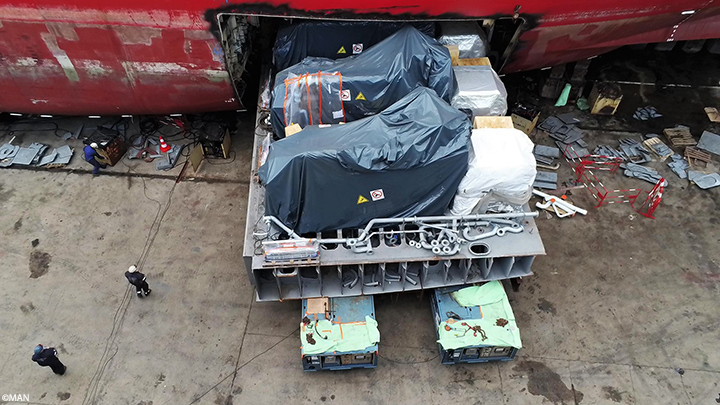First European diesel-powered dredger converted to dual-fuel operation
The “Samuel de Champlain” becomes first European diesel-powered dredger to be converted to dual-fuel operation, continuing MAN Energy Solutions’ unique record within this burgeoning field.
Based in the Port of Nantes-Saint-Nazaire on France’s Atlantic coast, the dredger “Samuel de Champlain” usually divides her time between the Loire and Seine estuaries. From a relatively workaday existence since entering service, the dredger has now hit marine headlines. Its engines received a high-performance upgrade from diesel-electric combustion to dual-fuel electric propulsion on liquefied natural gas (LNG) and marine gas oil (MGO) – a notable world first.
Dragages-Ports is an entity tasked with the key role of keeping the wheels of commerce turning in seven major metropolitan French maritime ports by maintaining the depths of their channels. The company ordered the retrofit of the Samuel de Champlain as part of a larger, ambitious environmental protection program known as the “S/F Samuel LNG Project,” supported by the European Union. Retrofitting the dredger demonstrates the feasibility of using LNG as a cleaner fuel on smaller vessels, making them more energy-efficient and cost-effective by reducing fuel and engine-maintenance budgets, while simultaneously reducing particulate matter, CO2 and NOx emissions that cause air pollution.

The retrofitting of the dredger "Samuel de Champlain" starts

The new dual-fuel electric propulsion arrives.
At the forefront of energy efficiency
Such a high-profile project and its demands reduced the field of candidates for the retrofit to just a select few around the world. Ultimately, Dragages-Ports enlisted Damen Shiprepair & Conversion (DSC), the international shipyard group. DSC handles over 1,500 such jobs annually throughout the world. Damen chose MAN 35/44DF GenSets to power the Samuel de Champlain.
The Samuel de Champlain retrofit is the latest milestone MAN Energy Solutions has passed within the promotion and development of dual-fuel conversions and emission control technologies in the maritime industry in recent years. Being the pioneering evangelist of a “maritime energy transition,” the company is a firm believer when it comes to the decarbonizing potential of dual-fuel retrofits. Stefan Eefting, Senior Vice President of MAN PrimeServ, Augsburg explains: “A successful maritime energy transition has to start with LNG. A retrofit instantly reduces the emission level of the ship, which at the same time is ready to use completely carbon-neutral fuels once these are available. Such e-fuels can be generated from renewable energy using power-to-X technology. That way we can decarbonize shipping, and for operators it only takes a single retrofit.”To meet the IMO emission goals, it is not enough to build new low emission ships. We need to modernize and reduce the footprint of the existing fleet. The success of maritime energy transition depends on projects like this.
Prime examples of emission reductions
A prime example of Eefting’s thinking is represented by the “Wes Amelie” project from 2017. Here, MAN PrimeServ – MAN Energy Solutions’ after-sales division – retrofitted a Wessels Reederei 1,036-TEU feeder container ship to an energy-efficient multi-fuel, four-stroke, dual-fuel MAN 51/60DF unit. The first such retrofit of its type the world had ever seen, the Wes Amelie operates in the highly regulated Nordic and Baltic Seas, both Emission Control Areas where the ship needs to meet the highest emission standards and strictest limits for fine particles generated through its exhaust.
Encouragingly, MAN Energy Solutions can boast of many other, similar successes in recent years as it pursues a deliberate policy of decarbonization. Together with Hapag Lloyd, the company announced the upcoming retrofit of the 15,000-TEU vessel “Sajir” to use LNG emissions of 15-30%.2propulsion – another world’s first which, so the companies hope, will pave the way for converting more large ships to LNG, aiming for a reduction in COBut it is not just LNG conversions making waves within the retrofit sector. For the world’s leading operator of LPG vessels, the Oslo-listed BW LPG, MAN will retrofit four ships with HFO-burning engines to dual-fuel engines, which will run on LPG.Follow the crew on their work:
Urgent action for air quality
While shipping remains the most efficient and environmentally friendly way to move the world’s trade volume, MAN Energy Solutions is convinced that everybody has to rethink energy consumption in the light of the Paris Agreement. The need to decarbonize in order to improve air quality and fight global warming can be met with new technology.
The retrofit of the Samuel de Champlain marks another small step that contributes to this goal. Many more are needed, as Stefan Eefting points out: “The global fleet today consists of roughly 40,000 ships, each with a life span of several decades. To meet the IMO emission goals, it is not enough to build new low emission ships. We need to modernize and reduce the footprint of the existing fleet. The success of maritime energy transition depends on projects like this.”Explore more topics
MAN Energy Solutions is now Everllence.
We have adopted a new brand name and moved to a new domain: www.everllence.com. This page will also be relocated there shortly. We are working on shifting all pages to www.everllence.com.
